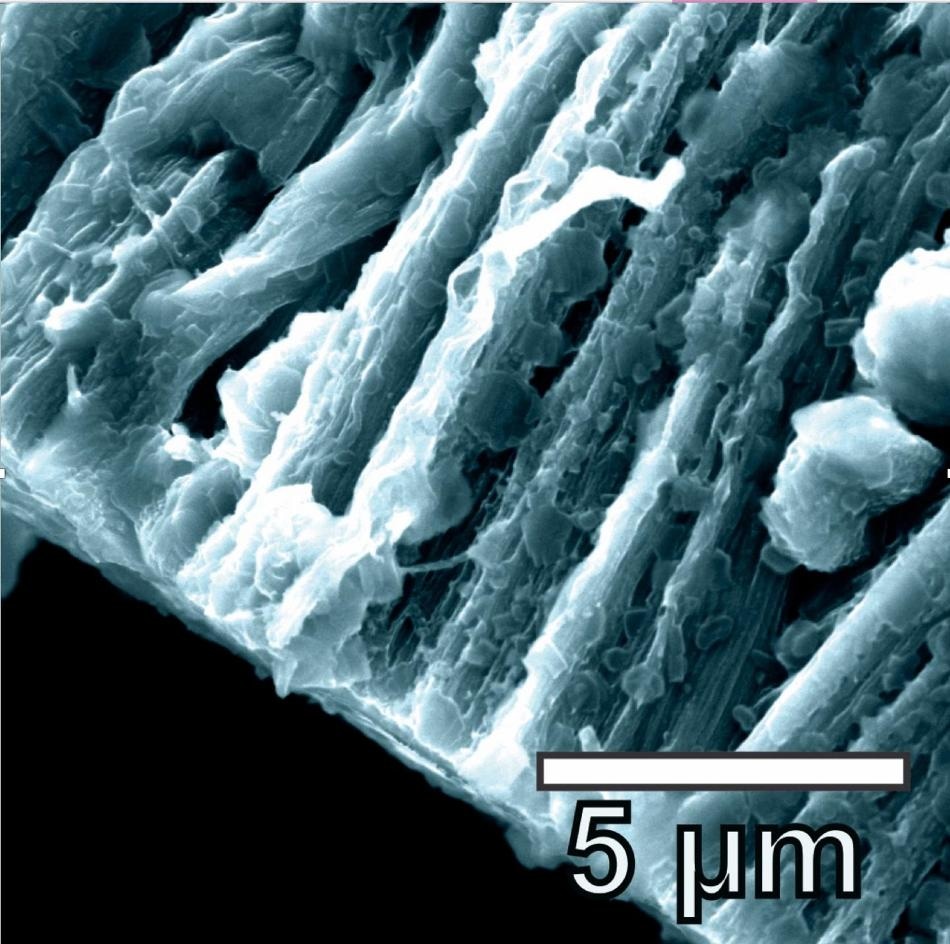May 19 2017
Researchers from the Rice University have developed a rechargeable lithium metal battery with a capacity that is three times that of commercial lithium-ion batteries. They achieved this by overcoming a problem that has challenged Researchers for a long time, namely, the dendrite problem.
 Lithium metal coats the hybrid graphene and carbon nanotube anode in a battery created at Rice University. The lithium metal coats the three-dimensional structure of the anode and avoids forming dendrites. CREDIT: Courtesy of the Tour Group.
Lithium metal coats the hybrid graphene and carbon nanotube anode in a battery created at Rice University. The lithium metal coats the three-dimensional structure of the anode and avoids forming dendrites. CREDIT: Courtesy of the Tour Group.
In the battery developed by Rice Researchers, lithium is stored in a distinctive anode, that is, a seamless hybrid of carbon and graphene nanotubes. The material was developed at Rice University for the first time in the year 2012 and is typically a three-dimensional carbon surface that offers a huge area for the storage of lithium.
The anode by itself reaches the theoretical maximum capacity for storing lithium metal and prevents the formation of detrimental dendrites or “mossy” deposits.
Efforts to substitute lithium-ion batteries with advanced lithium metal batteries with longer service life and quick charging ability have been hampered due to the formation of dendrites, which are lithium deposits formed inside the electrolyte of the battery. Bridging of the cathode and the anode by dendrites causes a short circuit, leading to failure of the battery, fire, or even explosion of the battery.
The Rice Scientists headed by Chemist James Tour discovered that when the newly developed batteries were charged, lithium metal was evenly coated on the highly conductive carbon hybrid through which nanotubes are covalently bonded to the graphene surface.
As described in ACS Nano, a journal published by the American Chemical Society, the hybrid takes the place of graphite anodes in common lithium-ion batteries that put safety over capacity.
Lithium-ion batteries have changed the world, no doubt, but they’re about as good as they’re going to get. Your cellphone’s battery won’t last any longer until new technology comes along.
James Tour, Researcher, Rice University
According to Tour, the nanotube forest of the new anode, coupled with its high surface area and low density, offers abundant space for the slip-in and slip-out of the lithium particles during the charge and discharge cycles of the battery, respectively. As lithium is evenly spread out, the current carried by ions in the electrolyte is also spread out and the growth of dendrites is restricted.
According to Tour, despite the fact that the capacity of the prototype battery is restricted by the cathode, the anode material reaches a lithium storage capacity of 3,351 milliamp hours per gram, which is very near to the theoretical maximum as well as 10 times that of lithium-ion batteries. He further added that the low density of the nanotube carpet enables lithium to be coated onto the entire substrate, thus ensuring maximal usage of the volume at disposal.
The “Aha!” moment of the Scientists was experienced in the year 2014 when Abdul-Rahman Raji, Co-lead Author of the study and a former Graduate Student in Tour’s lab, and at present a Postdoctoral Researcher at the University of Cambridge, started working with lithium metal and the graphene-nanotube hybrid.
I reasoned that lithium metal must have plated on the electrode while analyzing results of experiments carried out to store lithium ions in the anode material combined with a lithium cobalt oxide cathode in a full cell. We were excited because the voltage profile of the full cell was very flat. At that moment, we knew we had found something special.
Abdul-Rahman Raji, Co-lead Author of the study
Within a week, Raji and Rodrigo Villegas Salvatierra—Co-lead Author of the study and a Rice Postdoctoral Researcher—coated lithium metal onto a standalone hybrid anode to obtain a closer look by means of a microscope. “We were stunned to find no dendrites grown, and the rest is history,” stated Raji.
Tour stated that for investigating the anode, Researchers at the Rice lab developed full batteries including sulfur-based cathodes with the ability to retain 80% capacity at the end of over 500 charge-discharge cycles—which is nearly 2 years worth of use for a normal cellphone user. After the investigation electron microscope images of the anodes were taken, which revealed no indications of dendrites or other moss-like structures observed earlier on flat anodes. The Researchers also described that when viewed with the naked eye, anodes within the quarter-sized batteries were dark in color when they were empty of lithium metal, but were silver colored when they were full.
Many people doing battery research only make the anode, because to do the whole package is much harder. We had to develop a commensurate cathode technology based upon sulfur to accommodate these ultrahigh-capacity lithium anodes in first-generation systems. We’re producing these full batteries, cathode plus anode, on a pilot scale, and they’re being tested.
James Tour, Researcher, Rice University
Rice Postdoctoral Researcher Nam Dong Kim, visiting Researchers Xiujun Fan and Junwei Sha, and Graduate Students Yilun Li and Gladys López-Silva are the Co-Authors of the study. Tour is the T.T. and W.F. Chao Chair in Chemistry as well as a Professor of Computer Science and of Materials Science and Nanoengineering at Rice.
The study was supported by the Air Force Office of Scientific Research Multidisciplinary University Research Initiative.